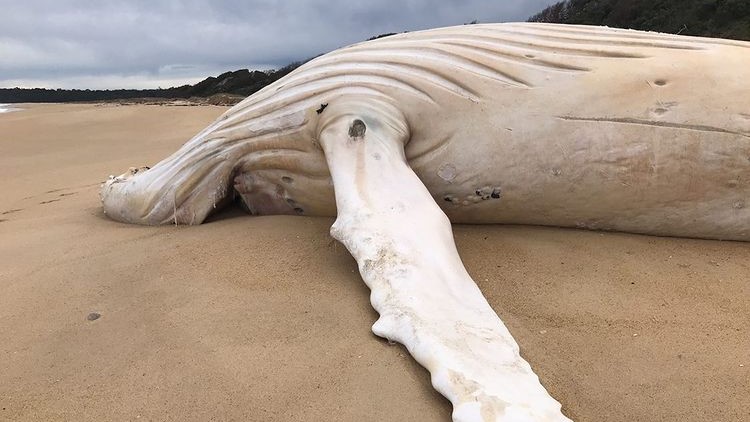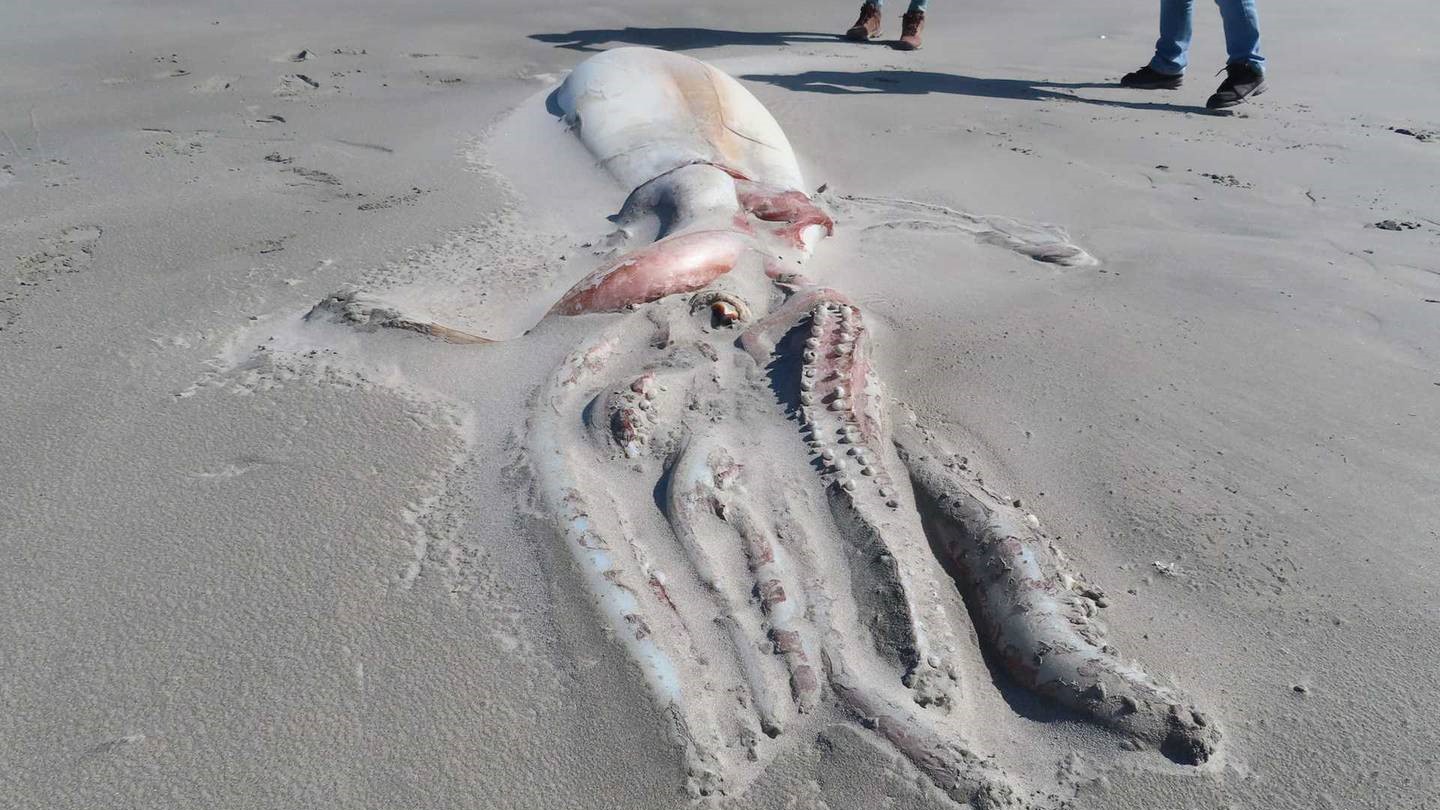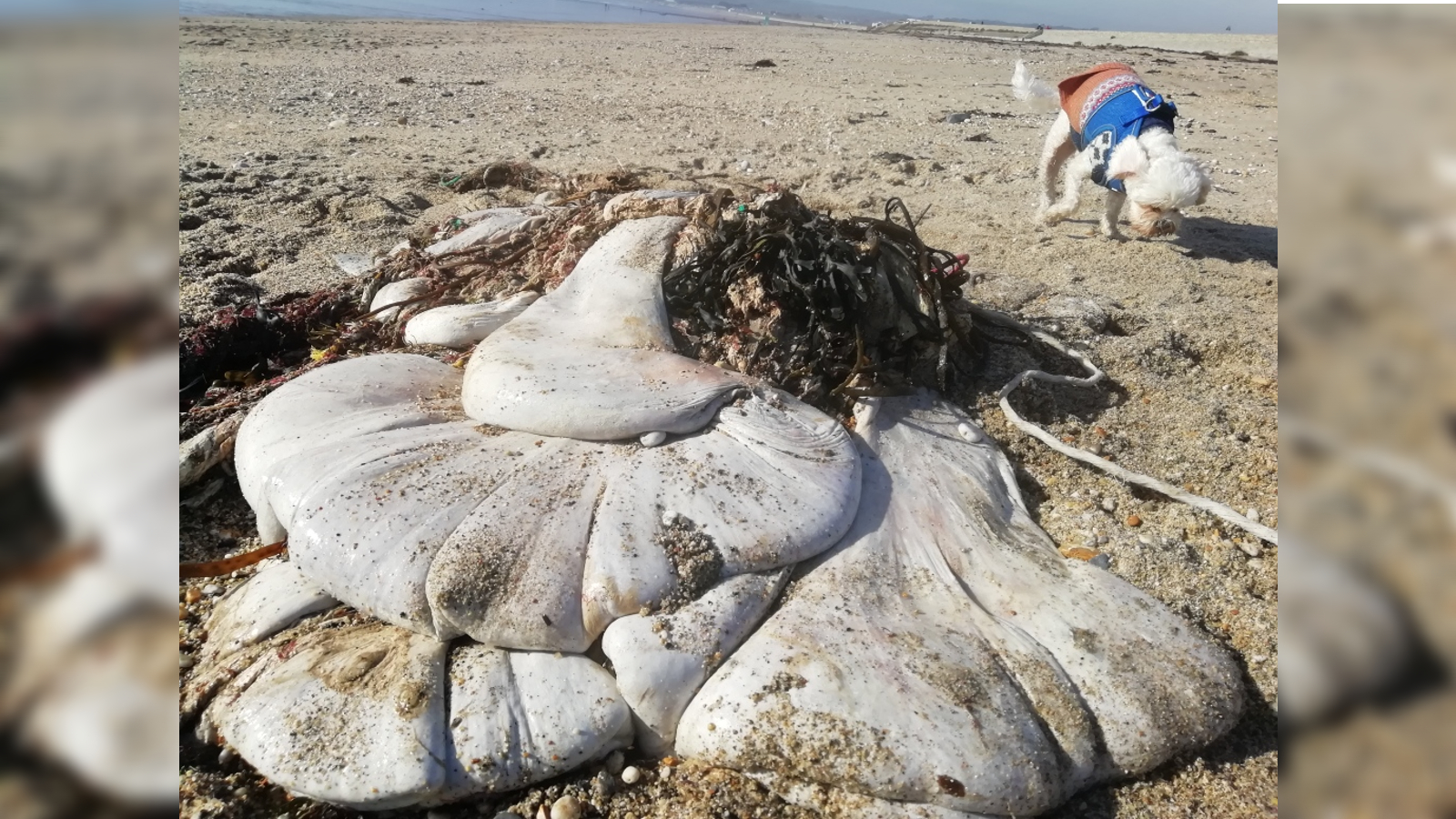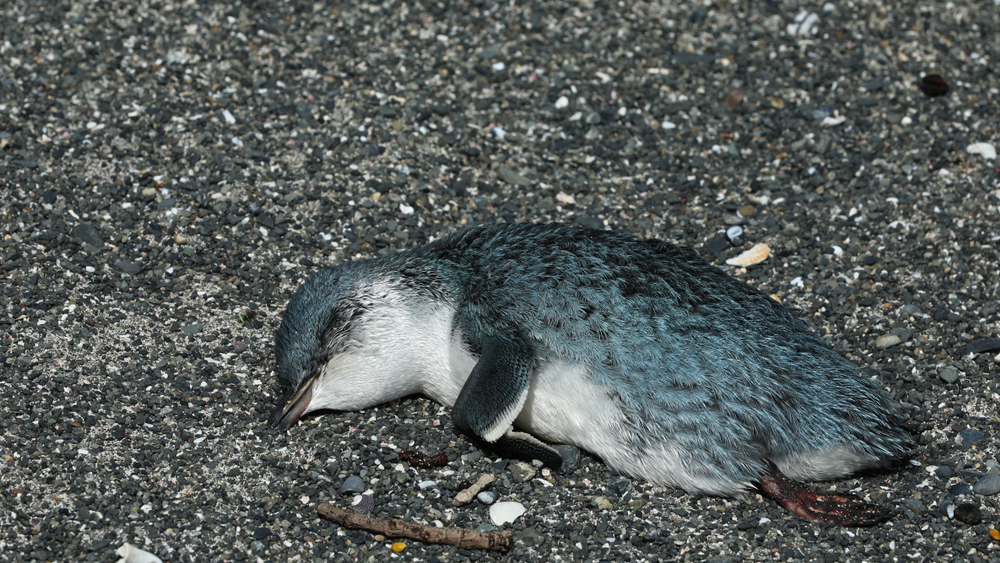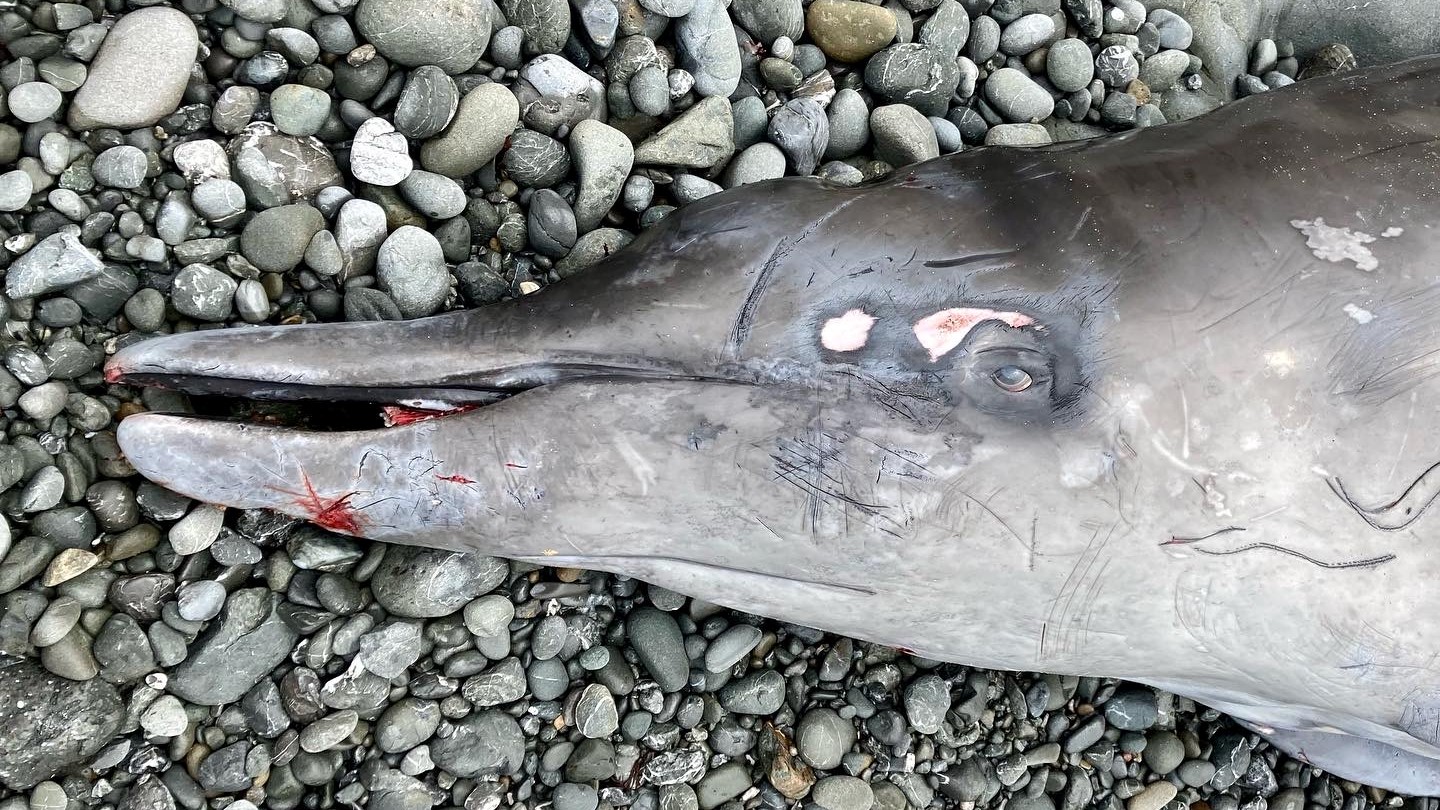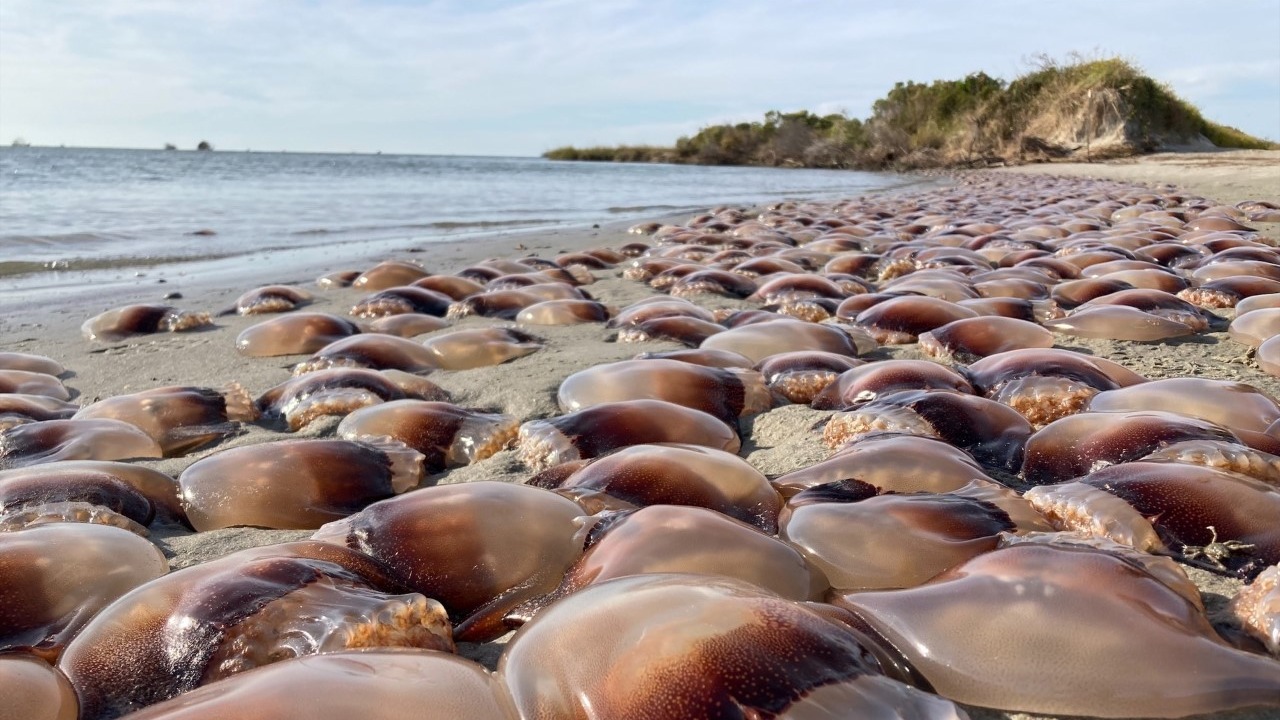10 bizarre creatures that washed ashore in 2022
A bunch of weird animals washed up dead across the globe in 2022. Here are our favorites.
Every year the remains of bizarre ocean creatures wash ashore on beaches across the globe, revealing clues about the lives of some of the most elusive and mysterious creatures on Earth. And 2022 was no different. From white whales and giant squids to tiny penguins and swarms of jellyfish, here are some of our favorites.
White humpback whale
A local man in Australia stumbled across a 33-foot-long (10 meters) humpback whale corpse while kayaking past a hidden beach in Victoria state. Surprisingly, the creature's body was "pure white" and looked more like a marble statue than a dead whale.
Despite the juvenile female’s extremely rare color, experts don't think the dead humpback (Megaptera novaeangliae) had albinism — a genetic condition that stops animals from producing skin pigment — because it had patches of dark skin.
Instead, the young whale may have had leucism, a genetic condition similar to albinism that affects some individual cells' ability to produce pigments and can cause patchy discoloration. It is also possible that most of the whale's outer skin fell off as it decomposed on the ocean's surface, which revealed lighter skin underneath.
Earlier this year, another possibly leucistic white humpback was spotted swimming with dolphins in New South Wales, Australia.
Read more: Extremely rare white humpback whale washes up dead on Australian beach
Half-eaten giant squid
One of the deep sea's most elusive and spectacular creatures, the giant squid (Architeuthis dux), astonished a group of tourists after it washed up with half-eaten tentacles on a beach in New Zealand.
Get the world’s most fascinating discoveries delivered straight to your inbox.
The colossal cephalopod, with a mantle measuring around 13 feet (4 m) long, was discovered on the beach at Farewell Spit, a nature reserve in the north of South Island.
Experts think the squid's half-eaten tentacles had been munched on by scavengers at the ocean's surface rather than being sustained during a deep-sea attack.
Washed-up giant squids are extremely rare, but Farewell Spit seems to be a hotspot for the beached behemoths: At least six giant squids have washed ashore there in the last 30 years.
Read more: Giant squid corpse with half-eaten tentacles stuns tourists on New Zealand beach
A whale's stomach
A strange, alien-like blob that washed up on a U.K. beach was probably a pile of whale guts, according to experts.
The massive stomach sacks were discovered by Cornwall resident Helen Marlow while she was walking her dog on Marazion Beach. The seaweed-covered lump appeared to be one singular object with no noticeable tears and did not give off any pungent rotting smells. "I couldn't bring myself to touch it, but I did try to move it with my boot and, as I did, it wobbled a bit like a big, fat jelly," Marlow told Live Science.
After uploading images of the mysterious object to Facebook, experts from the Cornwall Wildlife Trust's Marine Strandings Network identified the blob as a potential whale's stomach. The remains likely came from a large whale, such as a fin whale (Balaenoptera physalus), minke whale (Balaenoptera acutorostrata), humpback whale (Megaptera novaeangliae), sperm whale (Physeter macrocephalus) or bowhead whale (Balaena mysticetus) that had been ripped apart by scavengers on the ocean's surface.
Read more: Weird 'alien' sacks wash up on UK beach, most likely a whale's stomach
Hundreds of tiny penguins
More than 500 of the world's smallest penguins mysteriously washed up dead on beaches across New Zealand.
The little penguins (Eudyptula minor) washed up in several large aggregations within about a month on beaches across North Island. It was not immediately clear what killed the penguins, but experts noted that most of the dead seabirds were significantly underweight.
The most likely explanation for the demise of the adorable seabirds is that an increase in ocean surface temperatures, triggered by climate change, had forced their prey into deeper, colder waters, where the penguins could no longer reach them. As a result, the penguins lost almost all their body fat and either died from starvation or hypothermia.
Read more: Hundreds of the world's smallest penguins have mysteriously washed up dead. What killed them?
Aborted baby shark
A dead shark that was found on a beach in the U.K. was likely aborted by its mother shortly before birth.
The baby shark, which was most likely a common thresher shark (Alopias vulpinus), was found on Southbourne beach in Bournemouth, southern England. It was around 3 feet (0.9 m) long, which is slightly smaller than the average body length of a newborn thresher shark, and was identified as a female due to its lack of claspers (a shark's equivalent of a penis).
The shark's diminutive size and other anomalies, such as a lack of front teeth and the absence of growth rings in its vertebrae, suggest that it was aborted. Spontaneous termination of shark pregnancies can be triggered by high-stress scenarios and are more common than researchers previously thought. Experts think that the thresher's mother may have been accidentally caught by fishers, which caused her body to reject the pregnancy.
Despite being fairly common in U.K. waters, sightings of thresher sharks are very rare because they live deep below the surface. Adult threshers can grow to be 20 feet (6 m) long, but most of that length is due to their long, crescent-shaped tails, which they whip through the water to stun their prey.
Read more: Dead baby shark that washed up on UK beach was likely aborted by its mother
Mysterious beaked whale
The corpse of a mysterious beaked whale washed up on a Northern California beach with unusual wounds on its face and scrape marks all over its body. Experts were unsure what caused these injuries, how the whale died or even which species this pointy-nosed cetacean belonged to.
The remains of the unusual dolphin-like whale, which measured around 16 feet (4.9 m) long, were found on a beach at Jug Handle State Natural Reserve near Fort Bragg. A team of scientists from the nearby Noyo Center for Marine Science recovered the body and took samples of the whale’s blubber, organs and skull for analysis.
Scientists think there are around two dozen species of beaked whale in the family Ziphiidae, but of those only a few species have been properly studied. The Californian corpse was likely a Hubbs' beaked whale (Mesoplodon carlhubbsi) or a Stejneger's beaked whale (Mesoplodon stejnegeri), but it could also be ginkgo-toothed beaked whale (Mesoplodon ginkgodens) or a pygmy beaked whale (Mesoplodon peruvianus).
One possible cause of the whale's injuries is a vessel strike. Beaked whales and other cetaceans (the group that includes whales, dolphins and porpoises) are among the marine animals that are most at risk of being hit by boats.
Read more: Mysterious dead beaked whale covered in unusual injuries washes up on California beach
Jellyfish jamboree
Thousands of globular cannonball jellyfish (Stomolophus meleagris) washed ashore along a stretch of North Carolina coastline.
The "jellyfish jamboree" was spotted by park rangers from the Cape Hatteras National Seashore along the northern edge of Ocracoke Island, part of a chain of islands that makes up the Outer Banks.
The jellies are similar to actual cannonballs in both shape and size, weighing about 1 pound (450 grams) on average and measuring around 10 inches (24 centimeters) in diameter. The species is one of the most common types of jellyfish along the southeastern coast.
Experts believe the jellyfish swarm was triggered by an abundance of red drum (Sciaenops ocellatus) larvae, a favorite snack of the jellies.
Read more: Thousands of cannonball jellyfish wash ashore after swarming North Carolina’s Outer Banks
"Kraken" with massive eyes
A massive, sucker-covered giant squid carcass with eyes the size of dinner plates washed up on a beach in South Africa.
The "kraken" was found on the rocky shore of Scarborough Beach near Cape Town and was around 14 feet (4.3 m) long. Experts are unsure how the squid died but suggested it may have got stuck after venturing into unusually shallow waters to feed.
Interestingly, it was the second giant squid corpse to wash up in the area this year after an 11.5-foot-long (3.5 m) specimen washed ashore around 6 miles (10 km) away. It is unclear if there is a common factor behind the squids' deaths.
Read more: Giant 'kraken' carcass with dinner plate-size eyes washes ashore in South Africa
100 year-old Greenland shark
A super-rare shark that washed up on a U.K. beach could have been at least 100 years old.
The Greenland shark (Somniosus microcephalus) was first spotted on the sand in Newlyn Harbour, Cornwall, but it washed back out to sea. The shark, which measured 13 feet (4 m) long and weighed 628 pounds (285 kilograms), was then rediscovered floating off the coast a couple of days later and was hauled back to shore.
Greenland sharks are native to the Arctic and North Atlantic oceans and are believed to be among the longest-living animals in the world, capable of living to at least 272 years. They don't become sexually mature until they are around 150 years old — the size of this individual suggested it was only around 100 years old.
Pathologists later discovered evidence of meningitis, an inflammation of the protective membranes that cover the brain and spinal cord, which likely killed the shark.
Read more: Super-rare Greenland shark that washed up on UK beach may be at least 100 years old
Largest ever bony fish
A gigantic sunfish discovered near a Portuguese island set a new world record for the heaviest bony fish ever recorded.
The giant sunfish (Mola alexandrini) didn’t actually wash ashore — it was found lifeless on the ocean surface just off the coast of Faial Island, in the Azores, a group of islands in the North Atlantic Ocean. The humongous fish was around 12 feet (3.6 m) tall and around 11 feet (3.5 m) long, and it weighed a hefty 6,049 pounds (2,744 kg), or approximately 3 tons (2.7 metric tons).
The previous world record for the heaviest bony fish was held by another giant sunfish caught in Japan in 1996, which weighed around 5,070 pounds (2,300 kg).
Read more: 'Majestic' 3-ton sunfish sets a new world record for largest bony fish ever discovered

Harry is a U.K.-based senior staff writer at Live Science. He studied marine biology at the University of Exeter before training to become a journalist. He covers a wide range of topics including space exploration, planetary science, space weather, climate change, animal behavior and paleontology. His recent work on the solar maximum won "best space submission" at the 2024 Aerospace Media Awards and was shortlisted in the "top scoop" category at the NCTJ Awards for Excellence in 2023. He also writes Live Science's weekly Earth from space series.


